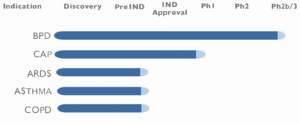AT-100 is a novel recombinant human protein rhSP-D – an engineered version of an endogenous protein – that reduces inflammation and infection while modulating the immune response to break the cycle of injury and inflammation.
AT-100 has several critical roles in maintaining healthy lung function:
1. Anti-inflammatory: SP-D has a significant anti-inflammatory function that is independent of its role in pathogen clearance [1-3]. Through a direct interaction with a variety of cell surface receptors, SP-D alters the signal transduction cascade in a variety of immune cell types, resulting in the modulation of inflammatory cytokine production [3].
2. Anti-infection: SP-D is a major component in the innate immune response system in the lung and has been shown to be important in the clearance of bacterial, viral and fungal pathogens [4, 5]. SP-D is known to bind bacteria and fungi, aggregate viruses, and promote opsonization and phagocytosis by macrophages through a variety of receptor-mediated mechanisms [5, 6].
-
2.1. COVID19: SP-D binds to and inhibits the replication of coronaviruses, the class of virus that causes COVID19 [7]. SP-D binding facilitates the clearance of coronavirus by lung immune cells and regulates the body’s immune cells to reduce the overwhelming inflammation that is often the primary mechanism of illness in severe viral infections. Finally, SP-D inhibits the infectivity and replication of several types of bacteria and viruses, therefore SP-D will not only inhibit the primary viral infection but also the secondary bacterial and viral infections that often complicate the care of COVID19 patients.
2.2. Influenza: SP-D is also known to be a potent inhibitor of Influenza A virus [8, 9]. Similar to COVID19, SP-D binding inhibits the replication of influenza virus and promotes the clearance of influenza virus from the lung by lung immune cells. In addition, SP-D regulates lung immune cells and breaks the cycle of inflammation and lung injury that results from influenza viral infection.
2.3. Respiratory Syncytial Virus: SP-D binds to Respiratory Syncytial Virus (RSV) and enhances the clearance of the virus by lung immune cells [10]. Deficiency of SP-D during RSV infection leads to increased inflammation in the lung and genetic deficiencies in SP-D function are associated with more severe disease in infants infected with RSV [10,11].
3. Lipid Homeostasis: Pulmonary lipids and proteins cover the surface of the lung alveoli, thereby reducing surface tension in the alveoli and keeping breathing effort to a minimum [12]. SP-D is required for the normal structure and function of lung lipids by regulating alveolar surfactant pool sizes and surfactant recycling by the alveolar type II cells [13-15].
- Kishore, U., Greenhough, T. J., Waters, P., Shrive, A. K., Ghai, R., Kamran, M. F., Bernal, A. L., Reid, K. B., Madan, T., Chakraborty, T. (2006). Surfactant proteins SP-A and SP-D: structure, function, and receptors. Mol Immunol, 43(9):1293-1315.
- Wang, J. Y. and Reid, K. B. (2007). The immunoregulatory roles of lung surfactant collectins SP-A, and SP-D, in allergen-induced airway inflammation. Immunobiology, 212(4-5):417-425.
- Haczku, A. (2008). Protective role of the lung collectins surfactant protein A and surfactant protein D in airway inflammation. J Allergy Clin Immunol, 122(5):861-879.
- Kingma, P.S. and J.A. Whitsett. (2006). In defense of the lung: surfactant protein A and surfactant protein D. Curr Opin Pharmacol, 6(3): p. 277-83.
- Wright, J.R. (2005). Immunoregulatory functions of surfactant proteins. Nat Rev Immunol, 5(1): p. 58-68.
- Crouch, E.C., (1998). Structure, biologic properties, and expression of surfactant protein D (SP-D). Biochim Biophys Acta, 1408(2-3): p. 278-89.
- Leth-Larsen R, Zhong F, Chow VTK, Holmskov U, Lu J (2007). The SARS coronavirus spike glycoprotein is selectively recognized by lung surfactant protein D and activates macrophages. Immunobiol, 212: 201-211.
- Hillaire, M. L., Haagsman, H. P., Oserhaus, A. D., Rimmelzwaan, G. F., van Eijk, M. (2013). Pulmonary surfactant protein D in first-line innate defense against influenza A virus infections. J Innate Immun, 5(3):197-208.
- Qi, L., Kash, J. C., Dugan, V. G., Jagger, B. W., Lau, Y. F., Sheng, Z. M., Crouch, E. C., Hartshorn, K. L., Taubenberger, J. K. (2011). The ability of pandemic influenza virus hemagglutinins to induce lower respiratory pathology is associated with decreased surfactant protein D binding. Virology, 412(2):426-434.
- Levine AM, Elliot J, Whitsett JA, Srikiatkhachorn A, Crouch E, DeSilva N, Korfhagen T (2004) Surfactant Protein D enhances phagocytosis and pulmonary clearance of Respiratory Syncytial Virus. Am J Respir Cell Mol Biol 31:193-199.
- Ampuero S, Luchsinger V, Tapia L, Palomino MA, Larranaga CE (2011) SP-A1, SP-A2 and SP-D gene polymorphisms in severe acute respiratory syncytial infection in Chilean infants. Infect Genet Evolut 11:1368-1377.
- Parra, E., Perez-Gil, J. (2015). Composition, structure, and mechanical properties define performance of pulmonary surfactant membranes and films. Chem Phys Lipids, 186:153-175.
- Ikegami, M., et al. (2005). Surfactant protein D influences surfactant ultrastructure and uptake by alveolar type II cells. Am J Physiol Lung Cell Mol Physiol, 288(3): p. L552-61.
- Ikegami, M., et al. (2000). Surfactant metabolism in SP-D gene-targeted mice. Am J Physiol Lung Cell Mol Physiol, 279(3): p. L468-76.
- Korfhagen TR, Sheftelyevich V, Burhans MS, Bruno MD, Ross GF, Wert SE, et al. (1998). Surfactant protein-D regulates surfactant phospholipid homeostasis in vivo. J Biol Chem, 273(43):28438-43.
Airway Therapeutics received Orphan Drug Designation for zelpultide alfa (AT-100) for prevention of BPD in the U.S. and Europe. Research shows the potential for rhSP-D in a range of other inflammatory diseases inside and outside the lung – serving as a pipeline.
- There is no commercialized product available globally for the prevention of BPD.
- Pivotal preclinical studies demonstrate that use of zelpultide alfa (AT-100) in animals treated with commercial lipid therapy prevent the sequelae leading to development of BPD better than that of surfactant therapy alone (current standard of care)
- These data provided the rationale for granting zelpultide alfa (AT-100) the orphan drug designation for prevention of BPD in both the U.S and Europe.
- Favorable feedback from the U.S. FDA & EU regulatory authorities:
- Preclinical program endorsed
- Clinical program endorsed – moving directly to phase II trial with only one randomized phase III study required




